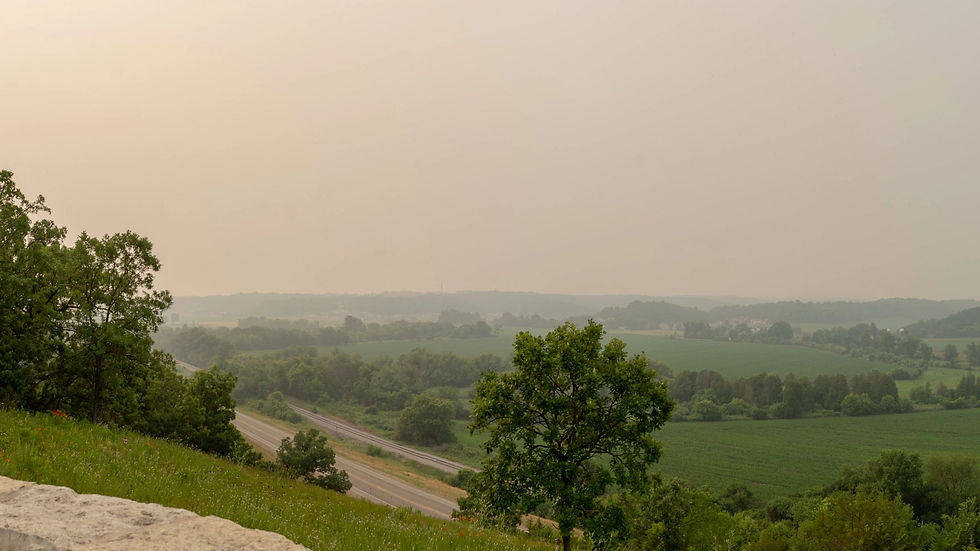Smokey Wisconsin and Pollinators
- matthew jackson
- Jul 2, 2023
- 3 min read
In recent years, the frequency and intensity of wildfires have increased globally, causing widespread ecological disruptions. Smoke generated from these wildfires can travel long distances, affecting regions far beyond their immediate vicinity. One such case is the smoke from Canadian wildfires that has blanketed parts of Wisconsin this past week, raising concerns about its potential impact on native pollinators and honey bees. In this blog, we will explore the possible consequences of this phenomenon and highlight the importance of protecting these crucial species and explore some possible solutions.

Before delving into the effects of smoke on native pollinators and honey bees, let us first understand their significance. Pollinators, including bees, butterflies, birds, and bats, play a vital role in the reproduction and survival of countless plant species. Their diligent work enables the transfer of pollen from the male parts of flowers to the female parts, facilitating fertilization and subsequent fruit or seed production. These interactions are fundamental to the maintenance of biodiversity, food security, and the overall health of ecosystems.
Smoke and Its Potential Impacts:
Disrupted Navigation and Foraging Patterns: Smoke can significantly hinder the flight patterns and navigation abilities of pollinators. Bees, for instance, rely on visual cues and scents to locate flowers. When smoke obscures their visibility or interferes with the scent trails, they may struggle to find food sources, resulting in reduced foraging efficiency.
Respiratory Stress: Pollinators have sensitive respiratory systems, and exposure to smoke can cause respiratory distress. Smoke contains fine particulate matter, such as ash and soot, which can be inhaled by bees and other insects. These particles can irritate their delicate respiratory tissues, leading to respiratory difficulties and impaired overall health.
Chemical Contamination: Smoke can carry a range of chemical compounds released during wildfires, including volatile organic compounds (VOCs) and harmful gases. When pollinators come into contact with these contaminants, they may experience toxic effects. Prolonged exposure to smoke-derived chemicals can weaken their immune systems, disrupt their hormonal balance, and increase their susceptibility to diseases and parasites.
Habitat Alteration: Wildfires can alter the landscape and destroy vital habitats for pollinators. Native bees, for instance, often rely on specific plant species for nesting and forage, which can be decimated by fires. The loss of suitable nesting sites and food sources can disrupt the life cycles of these bees, reducing their populations and exacerbating the already declining trend of pollinator populations worldwide.
Mitigating the Impact:
Protecting and Restoring Habitat: Efforts should be made to protect and restore habitats for native pollinators and honey bees. This involves creating diverse and pesticide-free landscapes that provide ample forage and nesting opportunities. Planting native flowering plants and maintaining green spaces can help ensure the availability of food sources for pollinators.
Monitoring and Research: Long-term monitoring programs should be established to track changes in pollinator populations and behavior following smoke exposure. Research initiatives can help us understand the specific impacts of smoke on different pollinator species and develop targeted strategies for their conservation.
Community Engagement and Education: Raising awareness among the general public about the critical role of pollinators and the potential consequences of environmental disruptions like smoke exposure is crucial. Encouraging individuals to create pollinator-friendly gardens, use bee-friendly agricultural practices, and reduce their carbon footprint can contribute to the conservation of these important species.
The smoke from Canadian wildfires that has enveloped Wisconsin serves as a stark reminder of the far-reaching impacts of environmental disruptions. While the direct effects of smoke on native pollinators and honey bees are not yet fully understood, it is essential to remain vigilant and take proactive steps to safeguard their well-being. By prioritizing habitat preservation, conducting research, and fostering community engagement, we can mitigate the potential consequences and work towards a more resilient future for our invaluable pollinators.

.png)




Comments